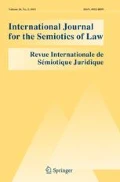Abstract
This article orientates Deleuze & Guattari’s pragmatic semiotics towards a semiotics of law. This pragmatic semiotics is explored, and directly related to the theory of emergence and complexity that is also a key feature of Deleuze & Guattari’s work. It is suggested that the development of these aspects of Deleuze & Guattari’s thought in relation to law allows the contours of a noological legal theory to be sketched out. Noology is the study of images of thought, their emergence, their genealogy, and their creation. A first exploration of this noological legal theory is then carried out by the conceptualisation of nome law as the first emergence of law as theorised by Deleuze & Guattari in the plateau “1837: Of the Refrain” from “A Thousand Plateaus”. This is a conceptualisation of law’s emergence in a far-from-equilibrium palaeolithic hunter-gatherer pack, and contrasts to accounts of law’s origin in a founding violence or mythical contract. It is the ‘big bang’ of legality, and the opening up of a first image of legality, problematic of social organisation, and anthropomorphic knowledge space.
Author information
Authors and Affiliations
Corresponding author
Rights and permissions
About this article
Cite this article
Murray, J. Nome law: Deleuze & Guattari on the emergence of law. Int J Semiot Law 19, 127–151 (2006). https://doi.org/10.1007/s11196-006-9014-0
Published:
Issue Date:
DOI: https://doi.org/10.1007/s11196-006-9014-0

